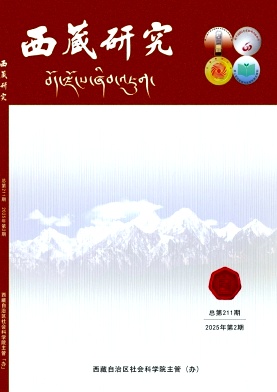| 196 | 0 | 38 |
| 下载次数 | 被引频次 | 阅读次数 |
玛朗历史上先后被吐蕃、亚孜、拉达克、贡塘、洛门塘、久姆拉等地方势力统治。1789年,廓尔喀占领普、纳尔、杰松多和尼湘地区,建立玛朗县。玛朗一直以来是藏传佛教和苯教在喜马拉雅南麓的重要传法地区,米拉日巴和猎人的故事就发生在尼湘扎嘎地方,该地的历史、宗教、民族构成以及族源等问题值得深入研究。
Abstract:Manang is one of the 75 districts of Nepal,and Chame is the headquarter of Manang. The northern part of the district is called Nar and Phu,and it adjacent with China. Gyalsumdo located in the southeastern,and Nyishang bordered with Mustang in the west. Manang was ruled by Tibet,Yatse,Ladakh,Gongtang,and Jumula,and successively. Nar,Phu,Nyishang,and Gyalsomdo were occupied by Gurkha in 1789,and established a new district in above areas. Tibetan Buddhism and Bon religions conducted frequent religious activities in the region,and the influence of the Gagyu sect is prominent. The great master Milarapa traveled and meditated in Nyishang,and the famous story of Milarapa and hunter was happened in Dragkhar cave in Nyishang. The Paper introduces and studies the religion,history and trading tradition of Manang district of Nepal.
[1]Nareswor,J.Gurung.An Ethnographic Note on Nar-Phu Valley[J].Kailash,1977(5).纳瑞斯瓦尔·古荣.纳尔---普山谷地区民族志研究[J].凯拉什,1977(5).
[2]Spengen W.The Nyishangba of Manang:Geographical Perspectives on the Rise of a Nepalese Trading Community[J].Kailash,1987(13).斯彭跟·W.玛朗地区的尼湘人:一个尼泊尔贸易社区兴起的地理视角[J].凯拉什,1987(13).
[3]王璐.尼泊尔的藏文化圈民族习俗[J].西藏民俗,1995(4).
[4]恰白·次旦平措.西藏史籍五部[M].拉萨:西藏藏文古籍出版社,1990.
[5]Grerson,G.A.Linguistic Survey of India(Tibeto-Burman Family Himalayan Dialects,North Assam Group),III:I[M].Delhi:Motilal Banarsidass,1967:41.葛雷森·G.A.印度语言调查(藏缅语系喜马拉雅方言北部阿萨姆)[M].德里:莫迪尔巴纳西达斯出版社,1967:41.
[6]Ragsdale,A.Tod.Gurungs,Goorkhaalis,Gurkhas:Speculations of a Nepalese Ethno-History[J].Contributions to Nepalese Studies,1990(17).格拉斯戴尔·托德.古荣、古卡和廓喀尔:尼泊尔民族历史的推测[J].尼泊尔研究,1990(17).
[7]Vansittart,Eden.Gurkhas[M].Calcutta.Superintendent Government Printing.1915:16.范西塔特·伊登.廓尔喀[M].加尔各答:督政府出版社,1915:16.
[8]维基百科[EB/OL].https://en.wikipedia.org/wiki/Iman_Xin_Chemjong.
[9]Chemjong,Iman Singh.History and Culture of the Kirat People[M].Kathmandu,Pushpa Ratna Sagar.1967:90-135.钦宗·伊曼.基拉特人的历史文化[M].加德满都:普什巴拉特纳出版社,1967:90-135.
[10]Aung,Maung Htin.A History of Burma[M].New York:Columbia University Press.1967:3-4.昂·貌廷.缅甸历史[M].纽约:哥伦比亚大学出版社,1967:3-4.
[11]Monier-Williams,Sr.M.A Sanskrit-English Dictionary[M].Oxford.Clarendon Press.1899:107.摩尼尔-威廉姆斯·M.梵英词典[M].牛津:克拉伦登出版社,1899:107.
[12]urung,H.Vignette of Nepal[M].Kathmandu.Sajha Prakashan.1980:67.古荣·H.尼泊尔小插图[M].加德满都:沙加巴卡山出版社,1980:67.
[13]Jackson,D.P.The Early History of Lo(Mustang) and Ngari[J].Contributions to Nepalese Studies,1976(4).杰克森·D.P.洛(木斯塘)早期历史[J].尼泊尔研究,1976(4).
[14]Mathes,Klaus-Dieter.The High Mountain Valley of Nar (Manang) in the 17th Century according to Two Tibetan Autobiographies[J].Journal of the Nepal Research Centre,2001(XII).梅斯·克劳斯-迪特.两部藏文自传记载的17世纪纳尔(玛朗)高山峡谷[J].尼泊尔研究中心学报,2001(12).
[15]Ramble,Charles and Seeber,Christian.Dead and Living Settlements in the Shoyul of Mustang[J].Ancient Nepal,1995(138).兰博尔·查尔斯,西伯·克里斯蒂安.木斯塘续玉村寨的前世今生[J].古代尼泊尔,1995(138).
[16]David Snellgrove.Himalayan Pilgrimage[M].London.1971:66.大卫·斯内尔格罗夫.喜马拉雅朝圣[M].伦敦,1971:66.
[17]Furer-Haimendorf,C.V.Bhotia Highlanders of Nar and Phu[J].Kailash,1983(10).福尔-海曼德尔夫·C.V.纳尔和普地区的高山藏族[J].凯拉什,1983(10).
[18]Gurung,N.J.An Introduction to the Socio-Economic Structure of Manang District[J].Kailash,1976(4).古荣·N.J.玛朗地区社会经济结构介绍[J].凯拉什,1976(4).
[19]Hildebrandt,Kristine and Perry,Joseph.Preliminary Notes on Gyalsumdo,and Undocumented Tibetan Variety in Manang District,Nepal[J].Himalayan Lingusitics,2011(10).希尔德布兰德·克里斯汀,佩里·约瑟夫.关于杰松多和尼泊尔无证藏民的初步研究[J].喜马拉雅语言研究,2011(10).
[20]Macfarlane,Alan.Some Background Notes on Gurung I-dentity in a Period of Rapid Change[J].Kailash,1989(3-4),Volumn 15.麦克法兰·艾伦.快速变化时期古荣身份的一些背景说明[J].凯拉什,1989(15).
[21]南喀诺布.古代象雄与吐蕃史[M].北京:中国藏学出版社,2009:82.
[22]王尧,陈践.敦煌本吐蕃历史文书[M].北京:民族出版社,1980:25-26.
[23]张云.《通典·吐蕃传》的史料价值[J].中国边疆史地研究,2002(3).
[24]Vinding,M.and Gauchan,S.The History of the Thakaali According to the Thakaali tradition[J].Kailash,1977(5).文丁·M.,高茜·S.基于传统文化的塔卡里人的历史[J].凯拉什,1977(5).
[25]古格·堪钦阿旺扎巴.阿里王史(藏文)[M].托林寺千年纪念活动领导小组,1996.
[26]Ramesh K.Dhungel.The Kingdom of Lo (Mustang)-A Historical Study[M].Lusha Press,Kathmandu,Nepal,2002.拉梅什·顿格尔.洛(木斯塘)王朝:历史研究[M].加德满都:露莎出版社,2002.
[27]Regmi,M.R.Modern Nepal:Rise and growth in the Eighteenth Century[M].Calcutaa:Firma K.L.Mukhopadhyay,1975:76.雷米·M.R.现代尼泊尔:十八世纪的兴起与发展[M].加尔各答:穆库巴雅出版社,1975:76.
[28]查噶瓦·曲吉旺久.曲吉旺久文集(藏文)[M].加德满都,2011.
[29]达察·次旺杰.洛绒史集[M].拉萨:西藏藏文古籍出版社,1994:91.
[30]瑞贝坚参.米拉日巴道歌[M].长条经书.
[31]Vitali,R.The Kingdoms of Gu.Ge.Pu.Hrang[M].Delhi:Indraprastha Press.1996:398.维塔利·R.古格和普兰王朝[M].德里:英扎普拉斯塔出版社,1996:398.
[32]Ehrhard,F.K.Religious Geography and Literary Traditions:The Foundation of the Monestery Brag-dkar b Sam-gling[J].Journal of the Nepal Research Centre,2001(XII).埃尔哈德·F.K.宗教地理与文学传统:扎噶桑林寺[J].尼泊尔研究中心学报,2001(12).
[33]东噶·洛桑赤列.东噶藏学大辞典[M].北京:中国藏学出版社,2002.
(1)藏文文献对尼湘巴有多种拼写法,如■等。
(2)位于尼泊尔北部山区,与我国西藏吉隆县相邻。今天被称之为木斯塘,是英文Mustang的音译,英文Mustang是藏语■的音译。
(3)额:贡塘王赤杰布木德衮(1253-1280)统治时期,贡塘拥有13个“加措”(百户),其中就包括“额”(■)的地方。(■)
(4)本图是根据维母·斯番金(Wim Spengen)的“玛朗之尼湘人:地理视角下的尼泊尔崛起的贸易社区”一文中的地图改编:(Kailash,Vol 13.PP131-277)。
(1)喀来人:尼泊尔北部山区一民族,英文称Ghaley,是藏语■的音译,其中喀■是指面部,来■为英俊之意。
(1)木斯塘南部的一个村庄。
(2)南部洛门塘的一个地名。
(1)“辟木恰”,是蒙语bicig的音译,其含义是目录或法规。洛门塘地区发现了一些“辟木恰”,大多记载了当地历史、村规民约、传说故事等。
(2)藏文文献中有不同的拼写,如■等。而英语中拼写为Tusm,是藏语的音译。促木位于尼泊尔廓尔喀县北端,与我国吉隆县贡塘乡接壤。促木、怒日和顾塘三个地区是莲花生大师指定的秘境吉姆隆(■)所在地,也是米拉日巴尊者长期修行的地方,大师的米拉洞(■)、鼐觉洞(■)、萨窝洞(■)等均位于吉姆隆秘境。
(3)尼泊尔廓尔喀县境内,背面与我国吉隆县接壤。神山马纳斯鲁峰(■)位于怒日境内。
(4)怒日地区的一个村庄名,有■等不同拼写。
(5)玛湘嘉仓应为下部尼湘和杰松多地区。
(6)普日指纳尔和普地区。
(7)指构成洛门塘的七个地区(或村庄):曲桑、凯麦、孜昌、洛门塘、曲色、曲奴、苏康,这七个村庄分布在北部廓热拉(■)和南部凯麦(■)中间。
(1)贵迪应该是山名,在藏文中有■等几种不同的拼写。
(2)扎嘎是指白色岩石,扎嘎位于尼湘顾达山上。
(3)■
基本信息:
DOI:
中图分类号:K355.9;B929
引用信息:
[1]达瓦次仁,弓进梅.尼泊尔玛朗地区历史研究[J].西藏研究,2022,No.193(02):17-23.
基金信息:
